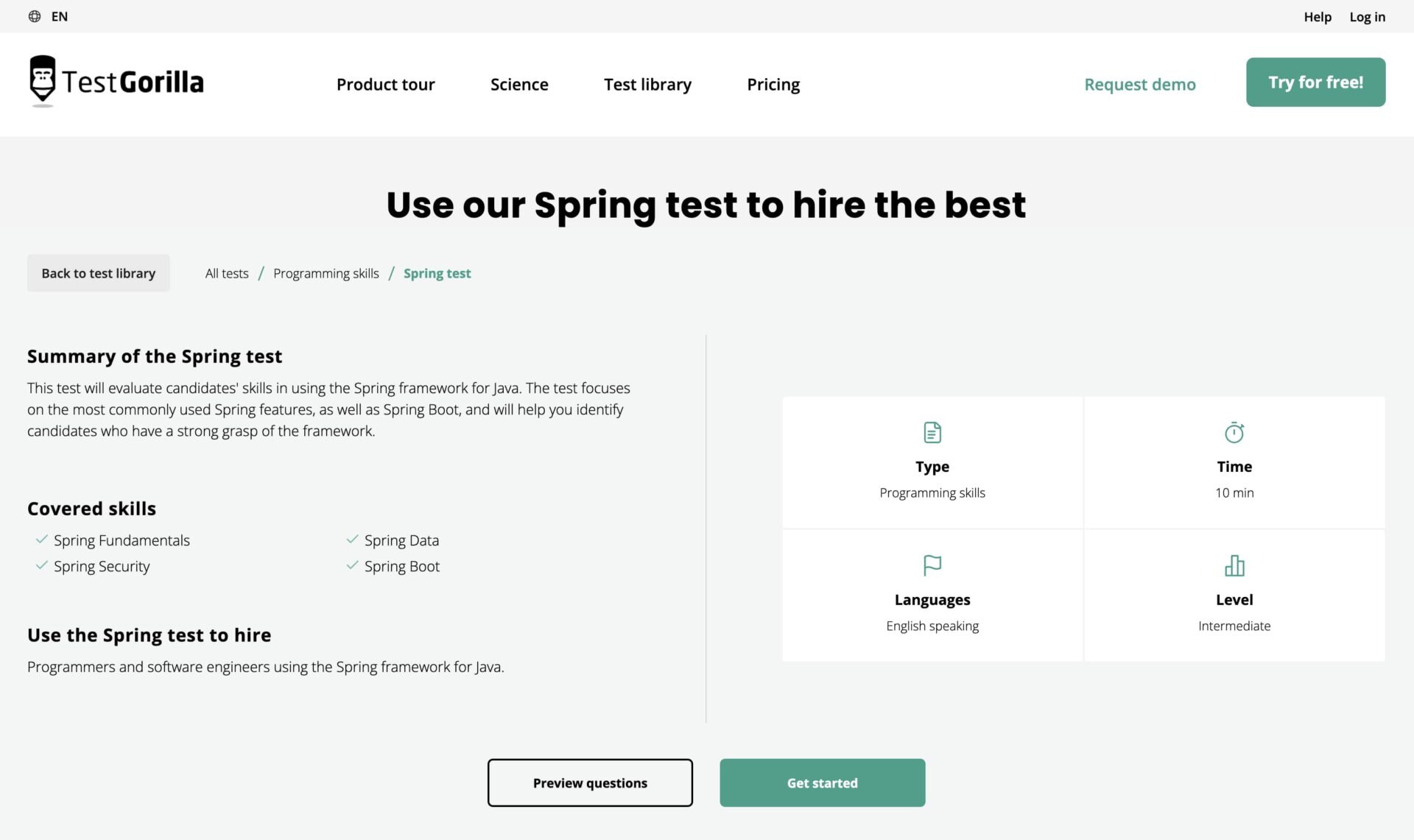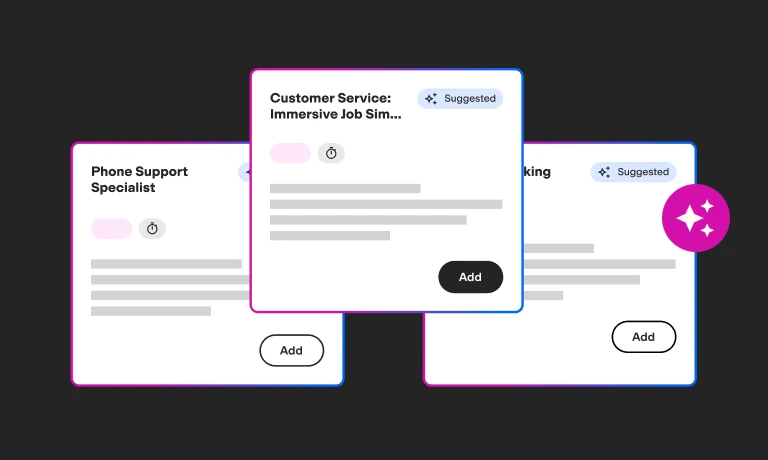Spring is the most popular application framework for Java and Java EE (Enterprise Edition) that developers use to build web apps.
Its first release dates back to 2003 but its popularity is as strong as ever. Its ease of use and small size mean that developers proficient in Spring are in high demand.
That’s why, if you’re looking to hire a Java Spring developer, you need to ensure a strong hiring process that assesses applicants’ skills fairly and objectively.
One of the best ways to evaluate candidates is with an online Spring test, in combination with other skills tests and a structured interview. In this article, we’ll look at the details of evaluating candidates accurately and free from bias, and we’ll give you a step-by-step blueprint for making your next hire.
Let’s dive in.
Top 5 must-have skills for Java Spring developers
In this section, we’ll review the top five skills all Java Spring developers should have and see how you can evaluate each one.
Of course, key skills may change depending on the exact role, so you’ll still need to write a detailed job description. However, you can use this section as a starting point for building your skills assessment (which we’ll discuss in more detail in the next section).
So, let’s look at the five most important skills for Java developers working with the Spring framework.
1. Spring framework knowledge
The first skill is the most crucial in the list: Spring framework knowledge.
The ideal candidate for a Spring developer role knows the most important features of the framework. They should also have experience with Spring Boot, which means they can develop Spring applications from scratch or configure, maintain, and update existing applications.
You can assess this skill with TestGorilla’s Spring Framework test. The test enables you to evaluate candidates’ knowledge of the fundamentals of Spring, Spring Data, Spring Security, and Spring Boot.
After identifying your best talent with the help of a skills assessment, you can use some of our Java Spring Boot interview questions to gain a deeper understanding of your applicants’ knowledge and skills.
2. Java skills
Next in line come strong Java skills. Any Java Spring developer should have a solid grasp of Java, and they should know how to use the programming language to build algorithms, manage data structures, or debug code.
These three sub-skills can be assessed with individual Java tests that you can find in our test library:
Each test evaluates a specific area of knowledge, so you should determine the most important for the role you’re looking to fill.
And you can complement these skills tests with the right common Java interview questions or Java interview questions about debugging.
3. Clean code
The best developers out there are those capable of using clean code when developing programs or code that is easy to read and maintain.
Clean code will save you hundreds of hours of development time and thousands of dollars. As such, it’s paramount that your developers know and can apply key software design principles, along with the SOLID design principles. This helps ensure that the code they write is simple and readable.
One of the best tools for assessing applicants’ knowledge of the principles of clean code is to use a Clean Code test.
4. Attention to detail (textual)
Attention to detail is another core skill that can help programmers spot mistakes in code – and resolve them before they result in bugs and interfere with applications’ performance or reliability.
This skill is best evaluated with an Attention to Detail test or another similar assessment. But you can also simply observe the way candidates communicate with you, especially in written form.
Do they make grammatical errors? Have you noticed any other mistakes that might be the result of oversight and carelessness? These can be red flags.
5. Critical thinking
Developers need to be strong problem solvers and be able to think critically when approaching new challenges. In software development, solutions are not always obvious or straightforward, and those with strong critical-thinking skills will be better prepared to resolve issues in innovative ways.
You can test applicants’ critical-thinking skills with TestGorilla’s Critical Thinking test or also with critical-thinking questions during the interview phase.
How to hire an expert Java Spring developer: A step-by-step guide
In this section, you’ll find a blueprint for hiring your next Spring developer with Java. As you’ll see, this doesn’t need to be a long and drawn-out process: If you use the right tools, hiring can be quick and efficient, even for technical roles.
Here’s your step-by-step guide on how to hire your next Java Spring developer:
1. Define the role.
First, you need to define the role’s exact parameters and responsibilities. What projects will the new hire work on? Which core skills do they need? What other skills may be helpful? What day-to-day tasks will they do? Write everything down in a job description and include this in your job ad.
2. Post a job ad.
Post your job ad on specialized job boards, social media, and on your own website. If you have an employee referral program, inform your employees that you’re hiring for this role and ask if they know anyone who might be suitable for it.
3. Create a skills assessment.
Based on the job description in #1, determine how you’ll evaluate your applicants’ skills. The most accurate and efficient way to do this is to use a skills testing platform like TestGorilla.
In our test library, you’ll find more than 220 tests, which you can combine in assessments (with up to five tests) to evaluate your applicants’ skills objectively. Remember to include a Spring Boot test for the best results.
4. Invite applicants to take the skills assessment.
Next, you need to invite applicants to take the skills assessment. This step can replace CV screening entirely because it’s a much more efficient way to analyze candidates’ strengths and knowledge.
5. Analyze results and shortlist applicants.
Look at applicants’ test scores and see who meets your criteria for the role and who demonstrated exceptional potential. Shortlist your best candidates and invite them to an interview.
6. Interview shortlisted applicants.
Next comes the interview stage. This is the most resource-intensive part of the hiring process, but thanks to skills tests, you’ll only spend time with applicants who truly have the right skills.
7. Make a hiring decision and extend an offer to your best applicant.
By now, you’ll have plenty of information about each applicant and their abilities. Discuss the results with your hiring team and extend an offer to your best applicant.
8. Inform unsuccessful candidates.
In many instances, companies fail to inform prospective hires that they weren’t selected. According to applicants themselves, this is the number one reason for negative candidate experiences. Providing feedback is an excellent opportunity to stand out and boost your employer brand.
9. Onboard your new hire.
The last stage – onboarding – is crucial for both the new hire’s performance and their overall experience at your company. Skills tests can be helpful here, too: Look at your new employee’s skills assessment results to create a personalized onboarding plan.
For the best results, use an onboarding checklist to make sure you’re not missing anything.
The best insights on HR and recruitment, delivered to your inbox.
Biweekly updates. No spam. Unsubscribe any time.
Hiring an expert Java Spring developer doesn’t need to be difficult
If you’re using the right approach to hiring, you can streamline your recruitment process, making it much less stressful and resource-intensive for everyone involved – including candidates.
Skills assessments enable you to design an objective and bias-free hiring process, especially if you combine them with other tried and tested evaluation processes, such as structured interviews.
To hire an expert Java Spring developer, remember to include TestGorilla’s Spring test in your assessment. This test will give you an accurate idea of candidates’ knowledge of the Spring framework and enable you to hire the best match.
Get started for free today and start making better hiring decisions, faster and bias-free.
Related posts
You've scrolled this far
Why not try TestGorilla for free, and see what happens when you put skills first.




















